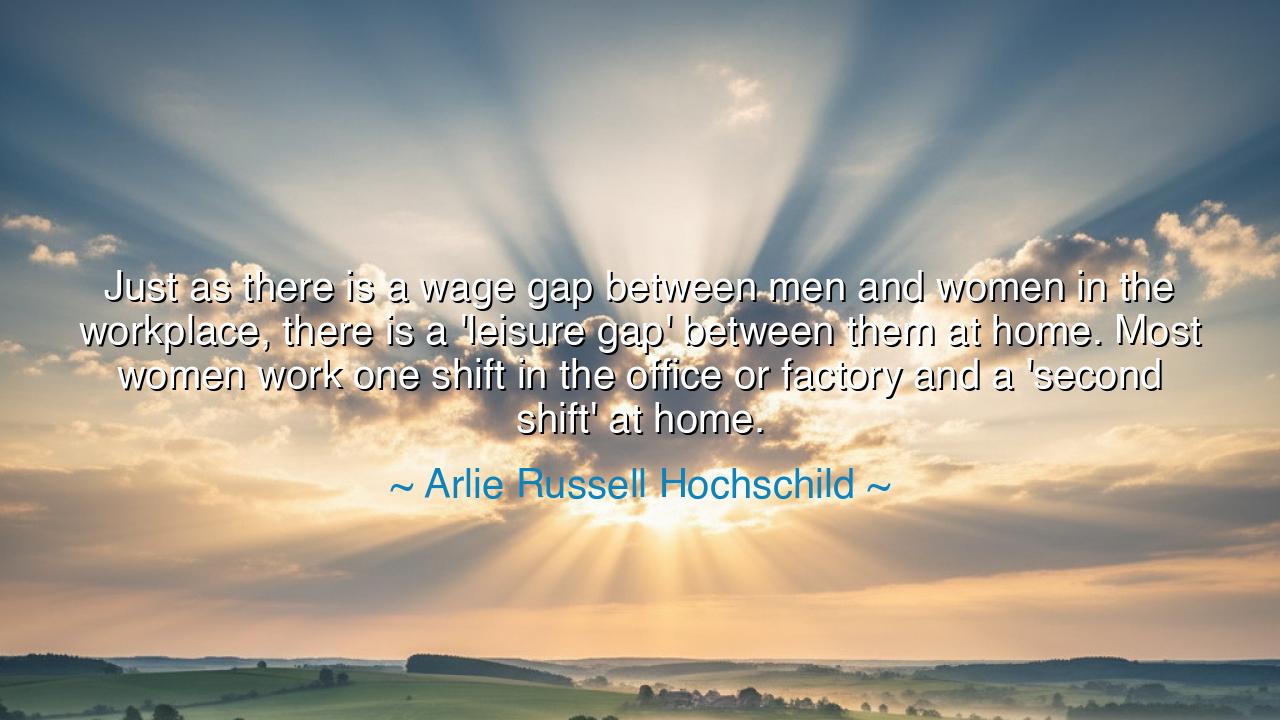
Just as there is a wage gap between men and women in the
Just as there is a wage gap between men and women in the workplace, there is a 'leisure gap' between them at home. Most women work one shift in the office or factory and a 'second shift' at home.






In the days when nations rose and fell like tides, the sages taught that justice must be weighed not only in coins but in hours. So speaks Arlie Russell Hochschild, whose field-walking among families revealed a hidden ledger: alongside the wage gap of the workplace yawned the leisure gap of the home. In her chronicles—most famously The Second Shift—she named the rhythm many had learned to endure but few had dared to inscribe: after the bell of paid duty, another, quieter bell summoned a second shift of domestic labor, care work, and unpaid labor. This, then, is the marrow of the saying: inequality is not only a matter of silver, but of seasons; not only of salaries, but of sunsets unshared.
Hear the meaning as one hears a drum beyond the hills. The leisure gap is the distance between two souls’ rest, the measure of who may lay down the yoke when evening cools the stone. While one returns from the market of wages to recline, the other returns to a hearth of tasks—preparing food, tending children, holding the woven net of family where it frays. The second shift is the invisible night watch of civilization. It is the reason some eyes are older by winter though their years are few, and some backs bend though no overseer stands behind them.
Consider the origin as one considers a spring at the mountain’s foot. Hochschild, like a careful scribe of daily life, entered homes and listened for the footfall of duty. She saw lists hidden behind the curtains, the mental scrolls of appointments, groceries, school forms, elder care—the mental load that never rests. Her words gathered these quiet labors into a single lamp, and the lamp gave a name to what countless mothers, daughters, partners, and wives had long known: that society’s accounts were balanced only by a currency no treasurer counted—time.
Take also a tale from history, to set this truth upon the anvil. In Iceland, in 1975, women ceased their unpaid labor for a single day. Factories stalled, schools faltered, newspapers grew thin. The land felt the absence of its hidden engine and learned that care work is not a soft thing, but the iron hinge upon which the door of public life turns. When the cooking and the cleaning and the comforting paused, the nation’s breath caught; and from that pause came reforms, and from reforms a clearer sight. Thus the story teaches: when the uncounted is counted, the commonwealth grows wise.
Or hear a humbler story, carried along the road like a water jar. Mei, a seamstress in a modern city, labored at her machine by day and at her stove by night. She rose before dawn to ready lunches, soothed a fevered child at noon, and after the clatter of factory needles, she scrubbed the floor to a quiet shine. Her husband loved her but did not see the whole river of her day; he drank from its surface and mistook it for a spring. One evening, weary, Mei laid her ledger upon the table—not of money, but of hours. He read, and the scales fell from his eyes. When he took the broom and she took the book, their house did not crumble; it stood more firmly, as if a new beam had been set beneath the roof.
Let the lesson be carved clearly, so that even the hurried may read it. If we prize fairness, we must measure not only paychecks but rest, not only promotions but free time; we must honor not only the workplace day but the home’s evening. Equality is not merely to split the gold; it is to share the twilight. To close the leisure gap and end the tyranny of the second shift, we must redistribute the visible chores and the invisible mental load, and we must teach children that a clean dish, a calm child, and a tended elder are triumphs worthy of any laurel.
Now, take up practical tools as one takes up seed and plow. First, make a household time audit: write down every task of domestic labor for one fortnight, counting minutes as carefully as coins. Second, agree to a fair division of labor—rotate chores, assign ownership of recurring tasks, and pair each duty with its unseen planning (not “helping,” but owning). Third, set sacred hours of leisure for each partner—time that cannot be bartered away. Fourth, if you are a leader, craft policies that close both gaps: paid family leave, flexible hours, equitable pay, reliable childcare. Fifth, in the city of the soul, honor the keepers of the hearth—speak gratitude, teach sons and daughters alike to carry the bowl and wield the pen. Do these, and the house will grow quiet in a good way, the evening long, the burdens light; and the society that springs from such homes will be straighter of spine and steadier of hand.
Remember, then: the wage gap wounds the purse, but the leisure gap wounds the spirit. And when the spirit is mended—when care work is shared and unpaid labor is esteemed—the night becomes a place of renewal, not residue. So let it be taught, and let it be done.






AAdministratorAdministrator
Welcome, honored guests. Please leave a comment, we will respond soon